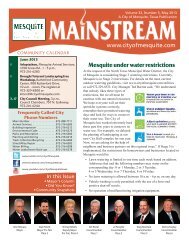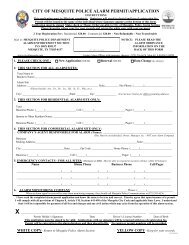airport/documents/Mesquite Master Plan Final.pdf - The City of ...
airport/documents/Mesquite Master Plan Final.pdf - The City of ...
airport/documents/Mesquite Master Plan Final.pdf - The City of ...
You also want an ePaper? Increase the reach of your titles
YUMPU automatically turns print PDFs into web optimized ePapers that Google loves.
a predetermined circling instrument<br />
approach under IFR.<br />
CLASS A AIRSPACE: see Controlled<br />
Airspace.<br />
CLASS B AIRSPACE: see Controlled Airspace.<br />
CLASS C AIRSPACE: see Controlled Airspace.<br />
CLASS D AIRSPACE: see Controlled<br />
Airspace.<br />
CLASS E AIRSPACE: see Controlled Airspace.<br />
CLASS G AIRSPACE: see Controlled<br />
Airspace.<br />
CLEAR ZONE: see Runway Protection<br />
Zone.<br />
CROSSWIND: wind flow that is not parallel<br />
to the runway <strong>of</strong> the flight path <strong>of</strong> an<br />
aircraft.<br />
COMPASS LOCATOR (LOM): a low<br />
power, low/medium frequency radiobeacon<br />
installed in conjunction with the<br />
instrument landing system at one or two<br />
<strong>of</strong> the marker sites.<br />
CONTROLLED AIRSPACE: airspace <strong>of</strong><br />
defined dimensions within which air traffic<br />
control services are provided to<br />
instrument flight rules (IFR) and visual<br />
flight rules (VFR) flights in accordance<br />
with the airspace classification. Controlled<br />
airspace in the United States is<br />
designated as follows:<br />
A-3<br />
• CLASS A: generally, the airspace from<br />
18,000 feet mean sea level (MSL) up to<br />
but not including flight level FL600.<br />
All persons must operate their aircraft<br />
under IFR.<br />
• CLASS B: generally, the airspace from<br />
the surface to 10,000 feet MSL surrounding<br />
the nation’s busiest <strong>airport</strong>s.<br />
<strong>The</strong> configuration <strong>of</strong> Class B airspace is<br />
unique to each <strong>airport</strong>, but typically<br />
consists <strong>of</strong> two or more layers <strong>of</strong> air<br />
space and is designed to contain all<br />
published instrument approach procedures<br />
to the <strong>airport</strong>. An air traffic<br />
control clearance is required for all aircraft<br />
to operate in the area.<br />
• CLASS C: generally, the airspace from<br />
the surface to 4,000 feet above the air<br />
port elevation (charted as MSL) surrounding<br />
those <strong>airport</strong>s that have an<br />
operational control tower and radar<br />
approach control and are served by a<br />
qualifying number <strong>of</strong> IFR operations<br />
or passenger enplanements. Although<br />
individually tailored for each <strong>airport</strong>,<br />
Class C airspace typically consists <strong>of</strong> a<br />
surface area with a five nautical mile<br />
(nm) radius and an outer area with a 10<br />
nautical mile radius that extends from<br />
1,200 feet to 4,000 feet above the <strong>airport</strong><br />
elevation. Two-way radio communication<br />
is required for all aircraft.<br />
• CLASS D: generally, that airspace from<br />
the surface to 2,500 feet above the air<br />
port elevation (charted as MSL) surrounding<br />
those <strong>airport</strong> that have an<br />
operational control tower. Class D air<br />
space is individually tailored and configured<br />
to encompass published instrument<br />
approach procedures.<br />
Unless otherwise authorized, all<br />
Airport Consultants<br />
www.c<strong>of</strong>fmanassociates.com




